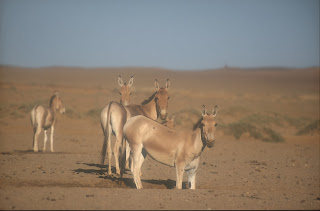 |
| Petrą Kaczensky Wikipedia CC-BY-SA3.0 |
In addition to these evolutionary relationships, genetic factors play a crucial role in shaping microbial colonisation and immune responses. Domestication significantly influences microbiome composition through changes in diet, habitat, and human-driven selection pressures. The external environment also contributes to microbial diversity, as hosts acquire microbes from soil, water, and food sources.
A study conducted by Victor Hugo Jarquín-Díaz and colleagues, and published in Scientific Reports, explored the contribution of environmental microbiota from freshwater sources to the gastrointestinal microbiomes of wild khulans (Equus hemionus hemionus).
The study also compared the faecal microbial diversity of wild khulans to that of captive khulans in Europe and two other equid species—Przewalski’s horses and domestic horses—in Mongolia. By examining these populations, the researchers sought to understand the extent to which environmental exposure and captivity shape equid gut microbiota.
They used PacBio sequencing (a DNA sequencing technique widely used for microbial genomics) and the LotuS pipeline for 16S rRNA gene sequencing, enabling a detailed analysis of microbial communities. The research team measured alpha diversity (species richness and evenness within a sample) and beta diversity (differences between samples) and conducted differential abundance analysis to identify microbial differences between groups.
Their findings showed minimal microbial exchange between wild khulans and their water sources, suggesting that freshwater sources have little impact on their gut microbiomes. They point out that this finding also indicates that khulans contribute little to waterborne microbial contamination, despite regular interactions with these water sources.
Comparisons revealed that wild khulans have a more diverse and richer gut microbiome than captive khulans. The researchers suggest that this is an adaptation to the harsh nutritional conditions of the Gobi Desert, where wild khulans must digest a wide range of fibrous, low-quality forage. In contrast, captive khulans have reduced microbial diversity, likely due to changes in diet, lower exposure to environmental microbes, and possible antibiotic use.
They conclude that their findings demonstrate limited microbial sharing between khulans and the waterholes they drink from, challenging the hypothesis that these act as a source of their gut bacteria or that khulans shape the water microbiome through their exudates. Captive khulans exhibit lower microbial diversity compared to their wild counterpart. However, captivity appears to be less of an influence than species differences – as the faecal biomes of captive and wild khulans are more like each other than they are to those of domestic horses and Przewalski’s horses.
For more details, see:
Jarquín-Díaz, V.H., Dayaram, A., Soilemetzidou, E.S. et al.
Unraveling the distinctive gut microbiome of khulans (Equus hemionus hemionus) in comparison to their drinking water and closely related equids.
Sci Rep (2025)15, 2767 (2025).

No comments:
Post a Comment